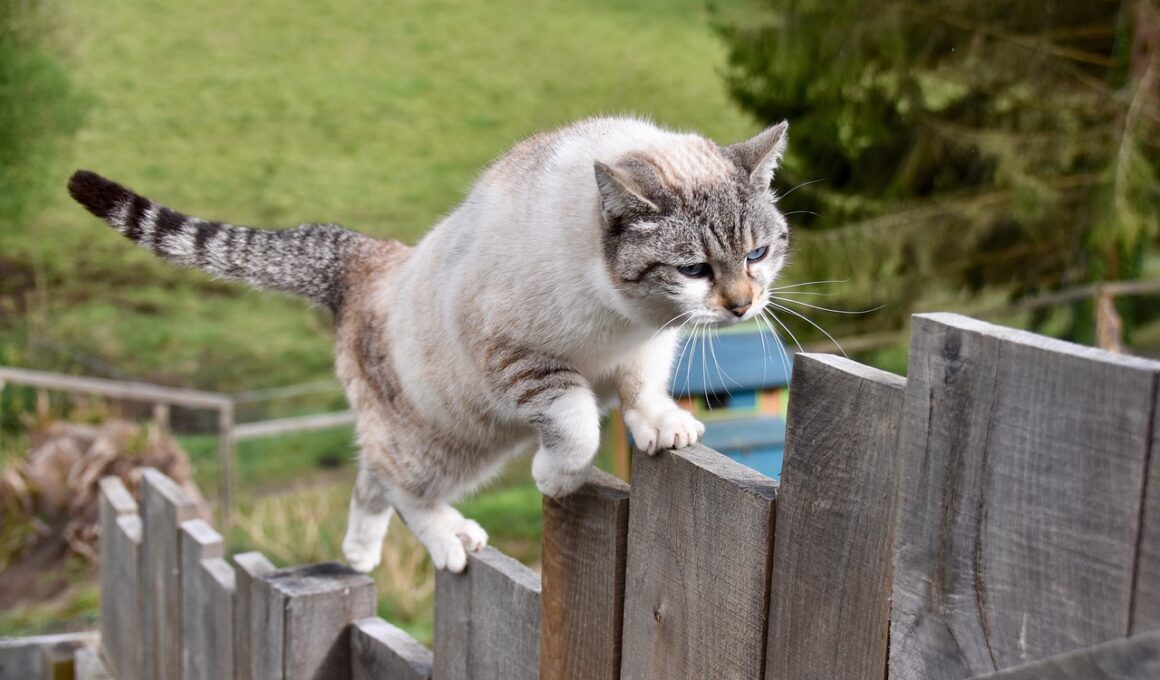Safety Precautions When Conducting Agility Training
Engaging in agility training with cats is an exciting experience but safety must come first. Before you begin training your feline friend, ensure that the training area is free from hazards. Remove any sharp objects, toxic plants, or obstacles that could pose risks during training. Setting up a designated area with soft flooring is ideal, as this will help cushion any falls. Also, using cones, tunnels, or jumps specifically designed for cats will enhance the training session while reducing risks. Always supervise your cat during exercise sessions; this helps identify potential dangers before an accident occurs. You should be prepared to intervene quickly, should your cat start to behave unpredictably. Be attentive to your cat’s physical condition, as overexertion can lead to injuries. Offering breaks between training can allow them to recuperate and maintain enthusiasm. Finally, remember positive reinforcement; rewarding good behavior reduces anxiety and fear, making the experience enjoyable for both of you. Keeping all these considerations in mind ensures a safe agility training environment your cat will love. Your cat’s safety is paramount, so remain vigilant and adjust training techniques as necessary to suit their needs.
Proper Equipment for Safety
To ensure safety during agility training, it’s essential to use appropriate equipment that accommodates your cat’s abilities and size. Look for lightweight obstacles that can be easily maneuvered, such as collapsible tunnels and adjustable jump bars. Ensure that all equipment is stable and securely anchored to prevent tipping or collapsing. Avoid using heavy materials which can cause injury if your cat accidentally knocks them over. When introducing your cat to agility obstacles, ensure they are familiar and comfortable with their surroundings. Gradually acclimating them to different elements helps build their confidence. Additionally, soft pads or mats can be used under jump bars to minimize any landing impact. It’s advisable to invest in gear designed specifically for feline agility, as this enhances safety during training. Keep an eye on your cat during their warm-up routine; stretching is vital to prevent muscle strain and promote flexibility. In case of persistent behavior and focus issues, consult with a veterinarian or a professional trainer who specializes in feline training. This can provide tailored advice that enhances both safety and performance, creating a positive experience while your cat develops their agility skills.
As with any physical activity, monitoring your cat’s health during agility training is crucial for overall safety. Before starting a training regimen, consult a veterinarian to ensure your cat is in optimal health and able to participate in rigorous activities. Certain medical conditions may limit your cat’s ability to engage in high-impact exercises. Additionally, track your cat’s energy levels throughout your sessions. If your cat shows signs of fatigue such as panting excessively or losing focus, it’s crucial to allow them time to rest. Hydration plays an essential role in preventing heat exhaustion during training. Always provide fresh water in the training area, encouraging your cat to drink during breaks. Furthermore, be mindful of the training environment; extreme weather conditions can impact your cat’s performance and safety. On hot days, choose to train in cooler hours or indoors, while in cold weather, ensure your cat keeps warm between runs. Each activity should feel fun and rewarding, not stressful, so prioritize your cat’s comfort. A good training session balances intensity and rest, ensuring your cat enjoys agility training while maintaining their health and wellness.
Training Techniques for Safety
Using safe training techniques is vital for successful agility training sessions. Start with fundamental commands like “come,” “stay,” or “jump” before introducing more complex obstacles. Familiarizing your cat with these commands lays a foundation for effective communication and helps manage their responses during training. Utilize clicker training to reinforce positive behaviors; timing your clicks with treats encourages your cat to repeat desired actions. When introducing a new agility obstacle, allow your cat to explore it at their own pace. This playful exploration fosters confidence and reduces anxiety. Gradually increase the challenge level as their skills improve, ensuring training sessions are enjoyable rather than overwhelming. Implementing short training intervals is key to maintaining your cat’s focus. Long sessions can lead to fatigue and disinterest, ultimately compromising their safety. Rewarding good behavior frequently encourages your cat to engage fully in upcoming activities. Additionally, observe for signs of discomfort or reluctance, and adjust exercises based on their comfort level. Creating a positive environment fosters a strong bond between you and your cat, which enhances the overall training experience while prioritizing the safety you’ve established from the outset.
Injuries can happen during agility training, so having a first-aid kit readily available is smart for safeguarding your cat. Essential items should include sterile gauze, antiseptic wipes, adhesive tape, and bandages specifically designed for pets. Knowing how to treat minor injuries can significantly reduce discomfort for your furry companion. Additionally, keeping contact information for your veterinarian or a nearby emergency animal hospital on hand is vital for urgent situations. Training isn’t always smooth sailing; accidents occur and knowing what to do makes you more prepared for them. Educate yourself on the proper techniques for handling various injuries such as cuts or sprains. If your cat suffers from a more severe injury, remain calm, and assess the situation carefully to avoid causing further distress. Sometimes, it might be best to seek professional assistance rather than attempting to treat an injury yourself. Maintain a cool-headed approach during any critical situation which will ensure your cat stays as calm and comfortable as possible. Being prepared with information and tools gives you the confidence to handle emergencies effectively while focusing on your cat’s safety and well-being during agility training.
Positive Reinforcement and Patience
Implementing positive reinforcement techniques during agility training can significantly impact your cat’s confidence and willingness to engage. Consistent rewards for successfully completing an obstacle or following commands encourage your cat to repeat desirable behaviors. Avoid the use of negative reinforcement, as it can lead to fear or anxiety, undermining the training experience. Always remember that cats respond best to patience and encouragement; understanding their unique personalities is crucial for your training success. Keep training sessions brief and fun, allowing your cat to remain eager to participate. Providing a mixture of challenges while avoiding excessive repetition nurtures enthusiasm and promotes a positive training atmosphere for your cat. Observe your cat’s reactions and be prepared to adjust your approach based on their energy levels. If your cat seems uninterested, switch to a simpler task or offer a short break with a favorite toy or treat. This flexibility ensures your cat feels valued. Creating a supportive and encouraging environment will help build a solid trust bond, essential for enhancing agility skills while maintaining safety at all times. Once your cat enjoys the learning process, it makes agility training a rewarding adventure for both of you.
In conclusion, agility training for cats can be a rewarding experience when prioritized with safety in mind. Understanding proper techniques, using suitable equipment, and being prepared for potential injuries establishes a strong framework for successful training sessions. Always ensure your cat remains comfortable, motivated, and active during practice. Encouraging positive experiences helps improve agility skills while reinforcing the bond between you and your furry friend. Patience, consistency, and love go a long way in developing competence, providing your cat with a stimulating outlet for their natural instincts. It’s essential to regularly assess your training approach, making adjustments as necessary according to your cat’s progress and comfort level. Utilizing engaging practices fosters a fun environment, motivating your cat to learn and explore new obstacles. Educate yourself about feline behavior patterns to better gauge your cat’s demeanor during training. With care and attention, you can create a safe, enjoyable agility training program, ensuring a delightful interaction experience that you both will cherish. Ultimately, the joy of agility training lies in the shared journey towards achieving new skills while ensuring your beloved cat’s safety is always a top priority.
Your cat’s hydration and comfort are essential elements of a successful agility training experience. Always keep fresh water available in their training area, offering chances to hydrate post-exercise. The right temperature in your training area can also significantly affect your cat’s performance. Too hot or too cold environments can lead to an unwillingness to participate or even cause health issues. Take time to observe signs of distress or fatigue during training exercises. If you notice uneven activity, it may signal a need for adjustments in your approach or a break. Learn to identify signs of stress; pacing, excessive grooming, or even vocalizations can indicate that your cat is overwhelmed. Addressing these signs early keeps your sessions both enjoyable and productive. Celebrate small victories and gradually work up to more challenging activities to prevent burnout. Balancing rigorous training with ample rest ensures your cat stays eager and playful during practice. To maximize the effectiveness of agility training, focus on creating a joyful, supportive atmosphere where your cat can shine, and exhibiting skills while nurturing their innate talents leads to shared satisfaction in your bond.


